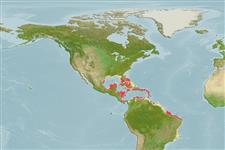Environment: milieu / climate zone / depth range / distribution range
पारिस्थितिकी
समुद्री प्रवाल-भित्ति संयुक्त; गहराई सीमा 3 - 23 m (Ref. 9710), usually 3 - 17 m (Ref. 9761). Tropical
Western Central Atlantic: Bermuda, eastern Gulf of Mexico and throughout the Caribbean.
आकार / वज़न / Age
Maturity: Lm ? range ? - ? cm
Max length : 15.2 cm TL पुल्लिंग / अलिंग; (Ref. 13442)
पृष्ठीय रीढ़ (सम्पूर्ण) : 10; पृष्ठीय सौफट रेज़ (सम्पूर्ण) : 14 - 16; गुदा कांटा: 3; ऐनल सौफट रेज़: 7. Body creamy white to pale yellow with six brown bars (the first of which runs through the eye, the second broad at nape narrowing towards the insertion of the pelvic fin, the third very wide, the fourth to sixth as wide as the second and evenly spaced behind the third bar); head and body with blue lines; pelvic fins vary in color, from white to yellowish; pectoral fins clear; caudal peduncle occasionally with a saddle (Ref. 26407).
A solitary species (Ref. 26340) inhabiting rocky and coral reefs (Ref. 9710). Always found near cover (Ref. 9710).
Life cycle and mating behavior
Maturities | पुनरुत्पत्ति | Spawnings | Egg(s) | Fecundities | लार्वा
Domeier, M.L., 1994. Speciation in the serranid fish Hypoplectrus. Bull. Mar. Sci. 54(1):103-141. (Ref. 26407)
IUCN Red List Status (Ref. 130435)
Threat to humans
Reports of ciguatera poisoning (Ref. 30303)
Human uses
मात्स्यिकी: व्यापारिक; जलजीवालय: व्यापारिक
साधन
Special reports
Download XML
इंटरनेट स्रोत
Estimates based on models
Preferred temperature (Ref.
123201): 25.3 - 28.2, mean 27.4 °C (based on 640 cells).
Phylogenetic diversity index (Ref.
82804): PD
50 = 0.5000 [Uniqueness, from 0.5 = low to 2.0 = high].
Bayesian length-weight: a=0.01778 (0.00680 - 0.04650), b=3.03 (2.80 - 3.26), in cm total length, based on LWR estimates for this (Sub)family-body shape (Ref.
93245).
Trophic level (Ref.
69278): 3.7 ±0.4 se; based on diet studies.
लौटाव (Ref.
120179): माध्यम, न्यूनतम जनसंख्या दुगनी होने का समय 1.4 - 4.4 वर्ष। (Preliminary K or Fecundity.).
Fishing Vulnerability (Ref.
59153): Low vulnerability (10 of 100).
Nutrients (Ref.
124155): Calcium = 77.5 [43.0, 153.4] mg/100g; Iron = 0.65 [0.35, 1.22] mg/100g; Protein = 18 [16, 20] %; Omega3 = 0.126 [0.074, 0.208] g/100g; Selenium = 24 [13, 49] μg/100g; VitaminA = 91 [24, 390] μg/100g; Zinc = 1.29 [0.82, 1.97] mg/100g (wet weight);
